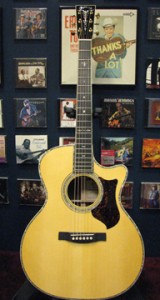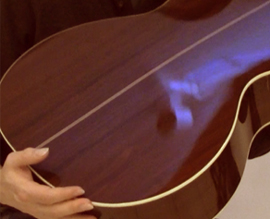One man’s words on…
GPC-42E Amazon Rosewood – Martin NAMM Special
Used Market Price: good luck!
Martin’s GPC-42E is 2011 NAMM Special, a limited edition available only through dealers who visited the Martin pavilion at the 2011 trade show in Anaheim, California. Like the 2010 OM Figured Koa, this year’s trade show special is among the most memorable.

The name stands for Grand Performance size with a Cutaway, in luxurious Style 42 and on-board Electronics. This is the first Martin in the new Grand Performance body size matched with a traditional, dovetail neck joint, hand-fittedinto a solid mahogany neck block. It also has the new High Performance neck that has put a smile on many faces and created considerable buzz since it debuted last year on the guitars in Martin’s Performing Artist Series.
The back and sides of this lovely musical instrument are made from bookmatched Amazon rosewood (Dalbergia spruceana) and the top is a high-grade of Adirondack spruce. Abalone heart pearl is used to inlay the sound hole rosette and the top purfling that gives Style 42 its refined appearance. Heart pearl tends to have more variance in color, with azure blue and emerald green glinting among the usual silvers and purples. The headstock has the ornate Alternate Torch design, also in heart pearl and over the top is an over-the-top version of the C.F. Martin & Co. script logo, inlaid with the same colorful shell.
The fingerboard designs carry the same ornamental theme from the rosette to the headstock with an unusual combination of cat’s eyes, notched diamonds and squares, as well as some unique and graceful fleurs that relate nicely to the torch at the top. The fret markers stop at the 3rd position rather than the 1st like Style 45, or the 5th as they do on Vintage Style 42, adding to the exclusive image of this new limited edition. But the nicest thing about this guitar is that is sounds and plays even better than it looks.
The color and grain of this Amazon rosewood most resembles the Brazilian variety that once grew along the coastal lowlands of South America and was the optimum choice for acoustic guitar bodies until it was harvested to the edge of extinction by industrial furniture makers. Many woods can be said to look like Brazilian. This stuff really does. The shading on this particular example was dark brown, but the grain resembled Brazilian closely. Photos of some other examples of this model look lighter and even more like Brazilian.
Amazon rosewood has great density, which results in an aural complexity that, in some ways, is closer to Brazilian than any other species. It also has a thick and smoky quality to the low-end harmonic undertone that is like or exceeds the darkest-sounding Brazilian.

Smoke is the term I use for how some guitar voices sound open and expansive, but still have varying degrees of colorful presence suspended in that three-dimensional tonal landscape,as it hangs and hums beneath sustaining fundamental notes, like drifting smoke suspended in a sunbeam coming through a window.In this regard, I would put it between Indian and Brazilian on the rosewood tonal pallet, as its undertone has dark lows and mids, but it is much more complex than Indian over all and closer to Brazilian in terms of the variety of detailed colors in the full voice – something I refer to as a wood’s complexity quotient.
I cannot think of another tonewood that has a bottomless pit of openness under the bass this similar to Brazilian. But Amazon’s lows head toward the opaque – murkier, with less light getting down there. The mids are not as open and airy and the trebles are as meaty as the densest Brazilian. Amazon still has more crayons in the box than other tonewoods, but they tend toward the darker, richer hues.
The lush Amazon rosewood on this guitar is complimented by the crisp, chiming properties of Adirondack spruce. This is a great choice for the topwood, as it accentuates the fat string ring but is otherwise transparent and helps open a clear window into the bass, accentuating the definition in the shadowy Amazon undertone as it rises up to cushion the individual notes coming off the strings.
A traditional neckjoint Martin has notes with the purity of a master built violin. The massive dovetail joint and solid mahogany neckblock allow the body and neck to exchange vibration that results in optimal resonance of the top and from the sound chamber. With this configuration on a guitar built from ultra-complex tonewood like Amazon rosewood, there is no need for soundboards that add in extra color and warmth. The reflective resonance of Adirondack spruce brings the Amazon undertone into detailed focus, while conveying a sparkling clarity in the harmonic angels ringing over the fundamentals. The new Grand Performance body shape further promotes this complex yet clear voice in a balanced and projecting manner.
The Grand Performance is Martin’s latest addition to their classic body sizes. It is rounder and bit wider than an OM and the depth is nearer that of a Martin dreadnought. It reminds me of the mini jumbos championed by Jim Olson and George Lowden and emulated by many others. The Martin GPs have better string to string balance than a 14-fret dread, fatter notes than an M and more bass response than an OM, yet they are smaller and easier to wield than a true Jumbo. They were made to accommodate a wide variety of playing styles and manage to do that with great success.
Since the GP was unveiled at NAMM 2010 I have wanted to see it on a guitar built with high-end woods and a traditional dovetail neckjoint. This is a marvelous first example. It has all the pure notes, resonance and harmonic complexity I could hope for. The bass is beefy and the low E string stands out in fingerpicking better than an OM, while the articulation during flatpicking is matched by sheer, punchy power during heavy-duty strumming that stays balanced, but still lets the bass notes out during pick and strum playing. And does it project? I happened to be capturing some video of this model as various Martin employees came out on their lunch break to check out the new models. The voice of this GPC-42E cut right through the conversations, clear as a bell.
All GP models come with the new High Performance neck that has an OM width at the nut, but is slimmer up the frets and less cheeky behind the fretboard. The 2-3/16” string spacing is unique to this neck and splits the difference between the standard Martin OM and Dreadnought spacing. Players of traditional wide-necked Martins may find the spacing a tad narrow for the picking hand, but those used to standard Martin necks will find it roomy yet still easy to play.
“I could totally get used to this!” said an enthusiastic Boo Reiners after spending a few minutes with the guitar. He is a heavy hitter in New York City’s Country Music scene who happened to stop in with a vintage Martin in need of repairs and stayed to check out the new models. Equally proficient in Bluegrass flatpicking and Tele-style fingerpicking, Reiners was quickly getting lots of spanky twang out of the new Adi top by over-attacking the strings, set up ultra low to show off the electric guitar feeling to the neck. We are both heavy-handed players and would have preferred higher action, but when laying back and letting the guitar guide the player to the sweet spot, it already sounds warm and woody but clear and chimey at the same time. Having broken in four new Adi tops in five years I can go to Vegas on the fact this guitar will sound as magnificent as a king’s ransom in two years time.
If this guitar weren’t impressive enough, it also has the new F1-Aura® sound system built right in. With discrete on-board controls, including a tuner and phase switch, the Aura® offers several EQ “images” that replicate the sound of this particular model as recorded through various, high-priced microphones set at different distances. I did not get to plug it in. I just had too many guitars to get through. But it is worth every penny it costs even if it didn’t have the on-board Aura®. With it, I feel the GPC-42E NAMM Special really is just too good to pass up if one is a gigging guitarist who wants a premium level instrument of the truest virtue and versatility, even if it is not quite like any Martin that came before it. David Crosby bought one while they were still be to had. I wish I had when I could have.
Pros: Warm, woody, wonderful rosewood under clear as a bell Red spruce in as versatile an acoustic guitar as one could hope for, with sumptuous appointments and state of the art amplification on board.
Cons: Neck and strings are narrower than dedicated fingerstyle guitars. The combination of the frilliest torch and pearl script logo may strike some as gaudy, limited to no more than 25 orders.
Bottom Line: Another stellar NAMM Special, the emergence of the Grand Performance size into the strata of top shelf Martins. At this rate, even committed traditionalists will soon see GPs as welcomed additions among the best guitars Martin has to offer.
I think I want one, Left handed and soon!
Unfortunately they didn’t make many and they were all sold long ago. If you can find one they go for a LOT of money. I would love to have one myself! I think it unlikely they made a lefty.